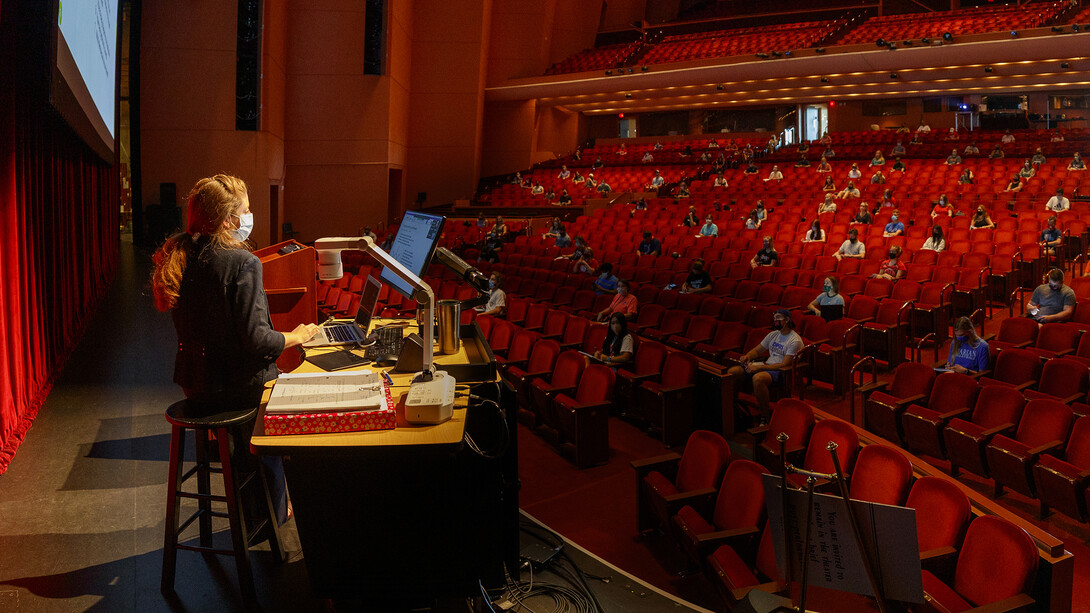
After a 147-day hiatus, the University of Nebraska–Lincoln community — armed with masks, hand sanitizer and social distancing — moved forward and returned to on-campus, in-person instruction on Aug. 24.
The transition from offering only remote instruction due to COVID-19 comes after months of preparation by faculty, staff, students and campus administrators. During that time, the university established a number of new polices and procedures designed to protect public health, developed plans to offer instruction both in-person and via remote access, and communicated about all of the changes to students (new and returning), faculty and staff. You can learn about that work on the university's COVID-19 response website or in these Nebraska Today stories.
To showcase the successful launch of in-person instruction, the University Communication team took to campus (from sunrise to well after sunset), capturing the day. Here are a few stories, social media posts and photos highlighting what the first day of in-person fall 2020 classes looked like for thousands of Huskers. You can also review more photos from the first day here.
Morning jump start
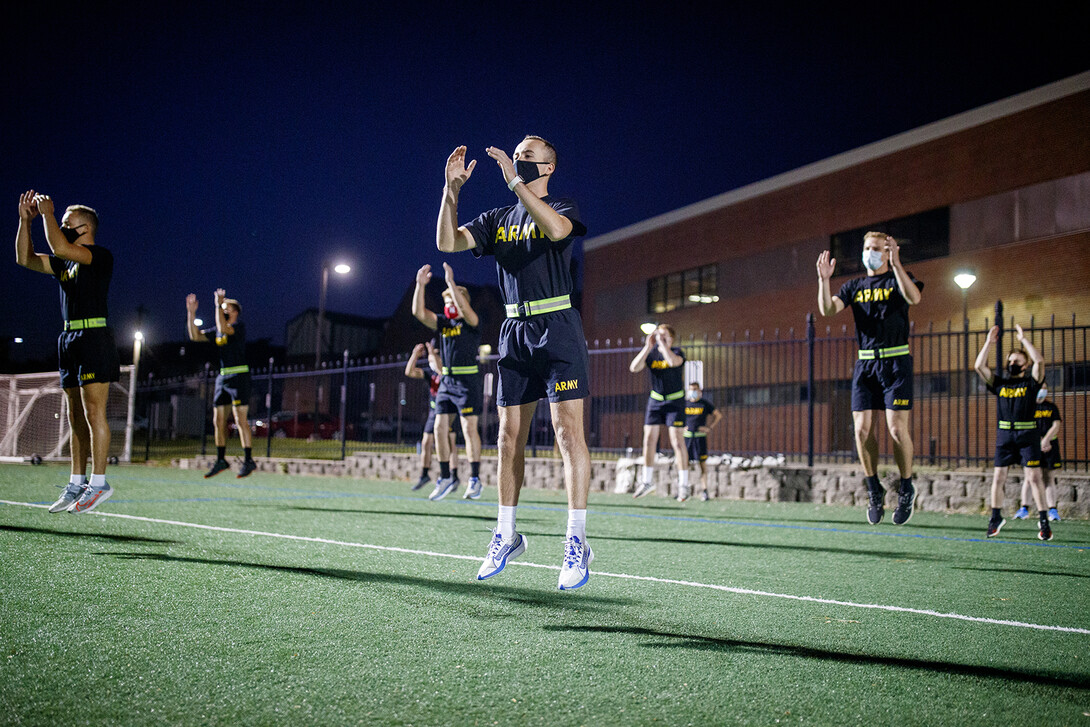
Trisha Vickrey | Chemistry

On Monday, the auditorium of the Lied Center for Performing Arts came to life for the first time in months.
Audience members weren’t there to see a Broadway musical or play. Rather, all eyes were on instructor Trisha Vickrey, who led three different organic chemistry lectures under the stage spotlight.
Vickrey and other members of the Department of Chemistry are teaching in the Lied Center this fall to accommodate the large number of students in each class while allowing for the necessary physical distancing between each person. The venue has a capacity of 2,200 people, and Vickrey’s lectures have 115 to 159 students each.
“Everyone at the Lied Center has worked really hard to organize everything to keep all the students safe, and they were so helpful to me today,” Vickrey said. “I am so glad to be back teaching students in-person as well as virtually.”
During Vickrey’s 8:30 a.m., 9:30 a.m. and 1:30 p.m. lectures, a projector was displayed on stage for students to watch. Some students, who chose to take the class remotely, used Zoom video conferencing to attend the lecture remotely. Those students were displayed on the projector for others to see.
"It was challenging to set up everything so that students could participate in all aspects of the course, either in-person or by Zooming in," Vickrey said. "The students were engaged and enthusiastic in both formats, and I am really glad that I had the support to organize the course in this way.”
— Lindsey Amen | University Communication
Popped in on a few classes today...so, so good to see @UNLincoln students back in classes today.....even if the classrooms look a little different! pic.twitter.com/ViJpQ9eBXP
— Ronnie D. Green (@RonnieDGreen) August 24, 2020
Cynthia Cress | Special Education and Communication Disorders
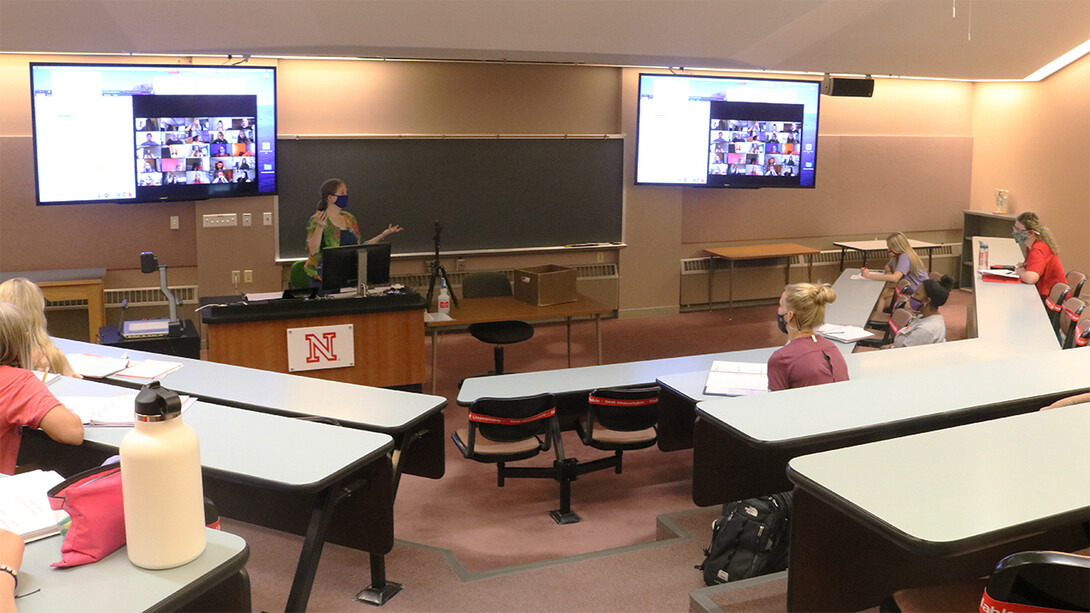
A summer bereft of any real break may have taxed Cynthia Cress, but it also paid off in the form of a plan that she believes will help compensate for the costs imposed by a crisis.
“You know, I’m feeling better than I did in spring,” said Cress, associate professor of special education and communication disorders. “I really am. Now that I’ve had time to plan for this, I’ve been able to adjust my instruction to accommodate this.”
“This,” of course, is the coronavirus pandemic and all of its attendant tumult — which didn’t spare Normal Language Development (SLPA 251), the undergraduate course that Cress began teaching in 1994 and again last week.
Though the class will meet three times a week, just one-third of the 53 students are rotating into 321 Barkley Center on a given Monday, Wednesday or Friday afternoon, with the other two-thirds attending virtually via Zoom. The cyclical schedule, which will allow students attending in person to maintain at least 6 feet of distance, has also encouraged Cress to continue a digital metamorphosis that originated in March.
“As of last fall, I really was a low-tech person,” she said. “I was a blackboard, overhead, paper-and-pencil kind of teacher. And as of last spring, I really had to ramp up considerably in online, remote instruction. I taught an entirely remote (course) this summer, and it went well. So it’s been a learning curve for me, but hey, if I expect the students to learn, I need to keep learning, too.”
Even as she taught that summer course, Cress was busy considering ways to keep her remote students engaged during the fall semester. When the pandemic forced her to teach remotely in the spring, she recorded and posted her lectures for later viewing but found that “the students really missed that in-person, live connection.” So Cress has decided to livestream every class period of SLPA 251 this fall in order to provide as equitable an experience as possible for every student, in-person and remote. She’s also promoting a variation on face-to-face learning that she hopes will make the virtual classroom feel a bit more like the physical one.
“When they are Zooming, I ask them — unless there’s some reason otherwise — to have their video on,” she said, “so that we can facially connect and so that they can stay engaged with me, as well as me with them.”
Even as she acknowledged the possibility of further obstacles, Cress said she’s heartened by the participation and maturity that her SLPA 251 students showed during the online-only opening week of the semester.
“I have seen students roll with the situation and make these accommodations and wear their masks and chime in to Zoom and do their assignments,” Cress said. “They have stepped up to the plate to be responsible scholars and citizens. And I’m proud of them.”
— Scott Schrage | University Communication
Outdoor teaching
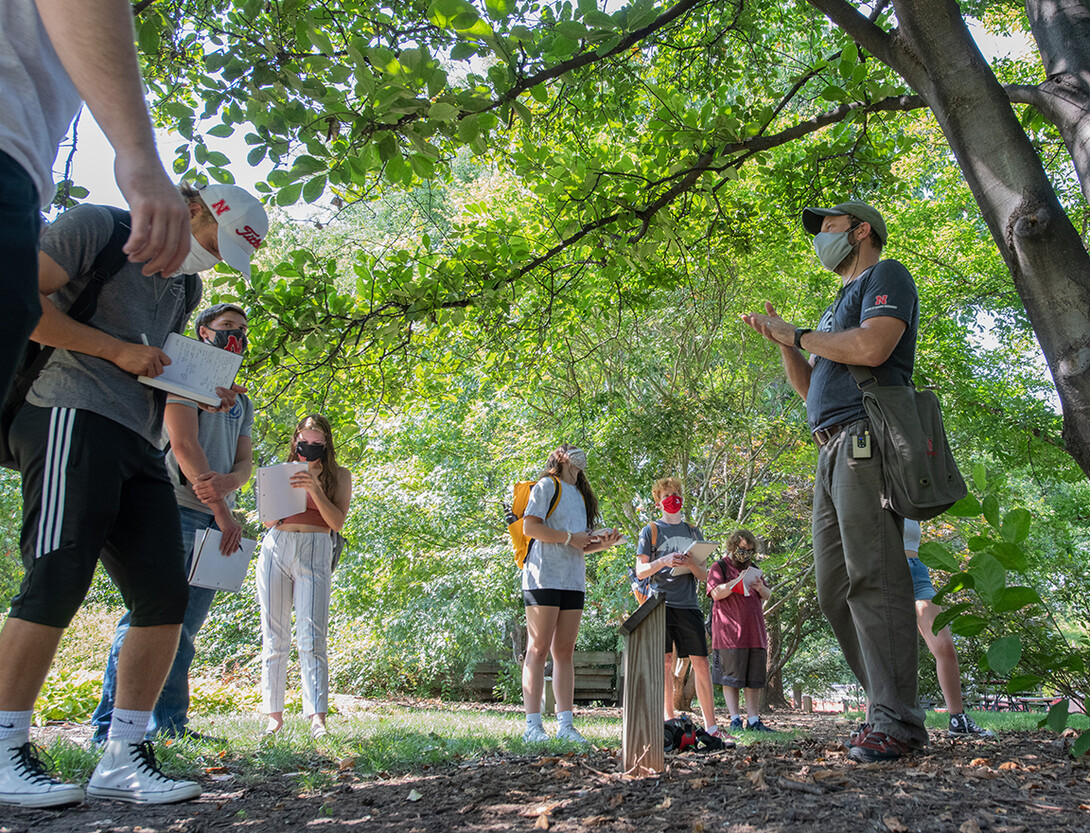
Nathan Koch | Music
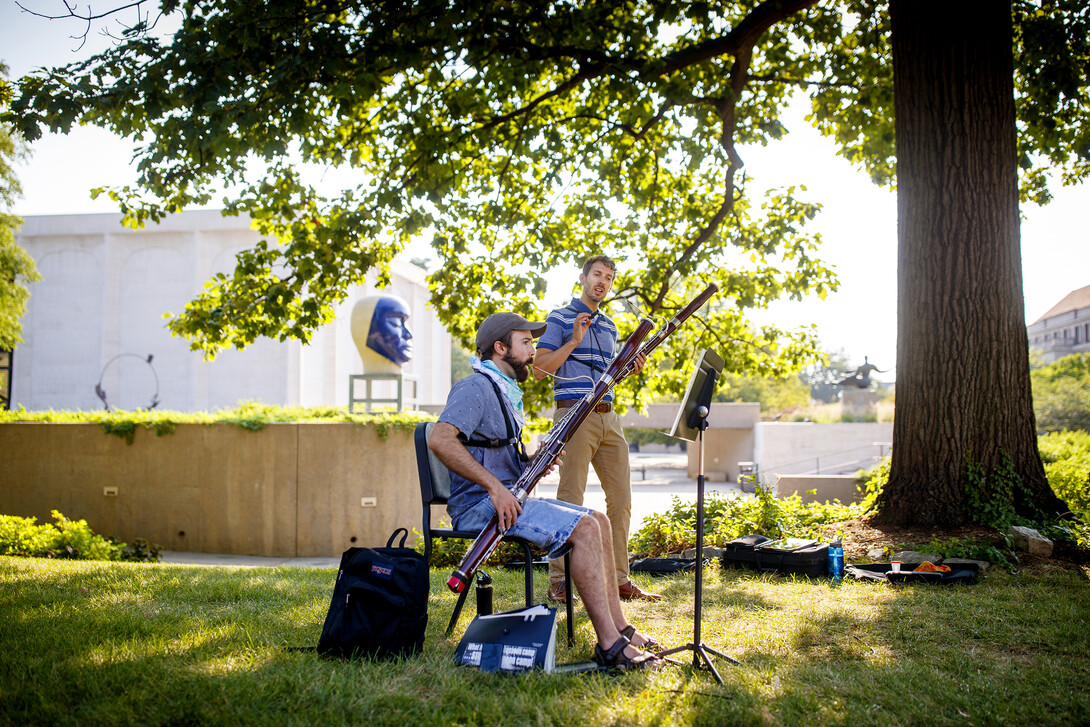
Nathan Koch, assistant professor of bassoon and music theory, is bringing his music lessons outdoors to keep students safe during the ongoing COVID-19 pandemic.
Koch met graduate student Tom Stark in the green space behind Sheldon Museum of Art for a private bassoon lesson Monday morning. As part of their degree, all graduate students in the Glenn Korff School of Music receive one-on-one instruction on a regular basis.
“Because playing, singing and shouting have been repeatedly shown to increase the concentration of aerosols in smaller spaces, many faculty, including myself, have chosen to teach our private lessons outdoors while the weather is nice,” Koch said. “Since it’s virtually impossible to play wind instruments with an effective mask on, this allows us to create a solid foundation with the student through in-person instruction while keeping the risks quite low. We will then be in a much better position to move to remote instruction as the seasons change or as campus protocols are updated.”
Koch plans to continue with the outdoor lessons as long as the weather allows.
“Out of necessity, we’ve had to get creative with how we navigate certain areas of the curriculum, but my students and I are looking forward to a memorable semester,” Koch added. “I’m incredibly grateful for the students’ support, flexibility and resiliency, and for all those who worked tirelessly throughout the summer to keep us as safe as possible this fall.”
— Lindsey Amen | University Communication
View this post on Instagram
A post shared by Caroline “Reee” Abels (@lineybean16) on Aug 24, 2020 at 6:28pm PDT
Matthew Schaefer | Law
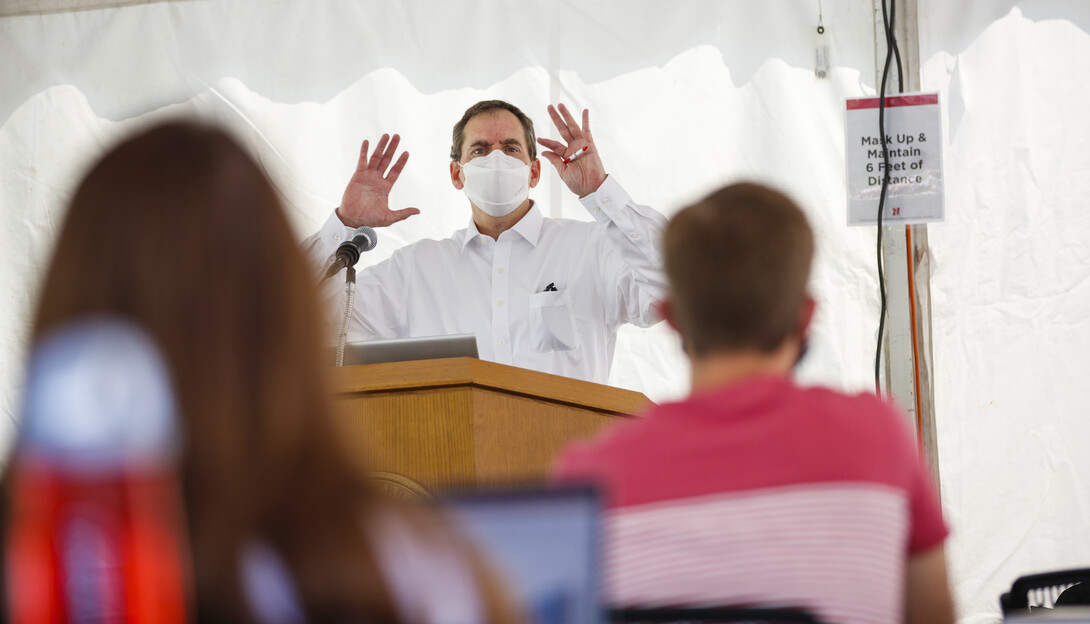
Matthew Schaefer hoped this week would be the warmest of Nebraska’s summer.
But even with the hot and humid August weather, Schaefer was happy to be greeting most of his students in person under a large white tent outside the University of Nebraska College of Law.
Schaefer is teaching two classes this semester — International Law at 9 a.m. and International Trade Law at 11:30 a.m. — both outdoors. He said the temps inside the tent were comfortable.
“The warmest week is likely to be this week and maybe the first week of September,” said Schaefer, the Veronica A. Haggart and Charles R. Work Professor of International Trade Law. “But I must say, it was very nice at 9 a.m., and at 11:30. With the shading, you don’t really notice it. September is such a beautiful month, and early October is so nice. It’s only going to get better climate-wise.”
CHECK THIS OUT: @UNLincoln College of Law is doing class outside...in a tent. They plan to hold class here, outside of the college until the beginning of October. All of this to help students stay safe while attending in-person classes! Way to go #Huskers!!! pic.twitter.com/TPP3SALihU
— alexaskonieski (@AlexaSkonieski) August 24, 2020
The law college is utilizing two large tents to help spread students out. One is dedicated for classroom instruction; the other is an outdoor study space. The tents will be used until Oct. 2, and possibly longer, if the weather permits. The instruction tent holds 16 students with social distancing. The study tent has about 20 seats for students.
Schaefer, who served on the college’s planning committee for fall in-person instruction, said the committee started thinking about classroom tents after University of Nebraska Medical Center instruction guidelines recommended considering tents for study areas.
“It’s another layer of protection, with the air flow,” said Schaefer “We’re still masked up and socially distanced, and we’re used to those things now, and these tents are just another area where we have to do that.”
Instruction in the tent also allows for broadcasting and recording the lectures on Zoom, so students who chose online-only instruction can be present with the class. This method of teaching isn’t new for Schaefer, as he’s led hybrid courses as the co-director of the college’s Space, Cyber and Telecom Law Program, that offers a masters of laws degree online and in-person.
Familiar with online instruction or not, Schaefer said preparations for the fall semester took everyone working around the clock.
“I'm just glad to see students get the opportunity to take advantage of an in-person classroom experience if they're a student who can do it,” Schaefer said. “Especially our technology team, Chris Evans and Richard McDermott, have gone above and beyond.”
— Deann Gayman | University Communication
Lab divided
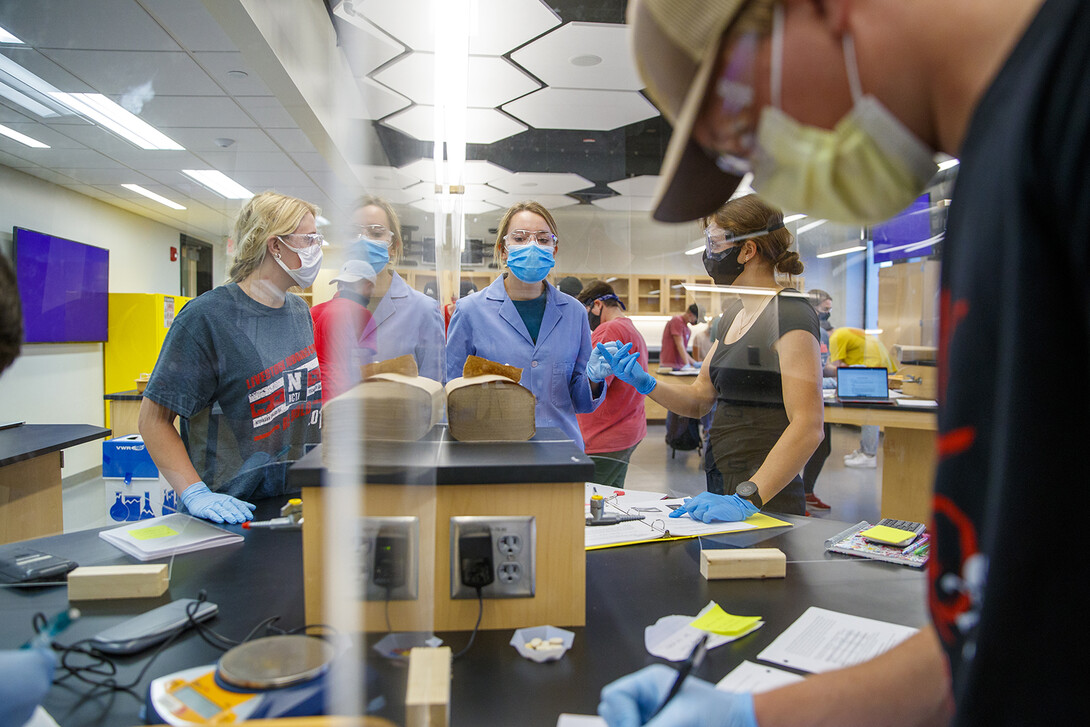
Lynne Nevin | Dance

The Johnny Carson Center for Emerging Media Arts looked much different Aug. 24 from its opening just a year ago.
As in-person classes resumed there, physical distancing was encouraged through spaced seating, signs, and floor and bench markers. Visitors were reminded to check in for contact tracing purposes and to utilize the hand sanitizing stations placed around the building.
Some things were similar though, thanks to careful planning by center, college and university leadership. The dance studios, which quieted in March, were inhabited again with dancers.
The black floors in each dance studio were divided into 10-square-foot squares and marked with white tape. The rooms were outfitted with new technology that allowed dance instructors like Lynne Nevin to speak into a microphone and Zoom screen that carried her voice and movements throughout the large room, and downstairs to a second studio where the other half of the class was participating. Nevin’s TA offered additional support downstairs, with plans to switch the students each week.
Nevin, who has taught at the University of Nebraska–Lincoln since 1991, said she felt safe the first day of in-person classes.
“We’ve had a lot of time to research and plan,” Nevin said. “We’ve followed recommendations from international dance organizations. Where the CDC says six feet of distance, dance organizations have recommended 10 feet because we’re out there getting everything moving.
“I was nervous before today, but all of the students were respectful of me and of each other. We were all masked. They were spread out and everything was marked.”
Nevin’s first class was Ballet I, where students are typically quieter because they don’t know each other yet, which presented a challenge.
“They were sedate today, as they are, and I kept smiling at them, trying to bring them out as I do, but now I have a mask on. I forgot they can’t really see that, so I tried to smile more with my eyes,” Nevin said.
Nevin said she is thankful for the work done throughout the university to make the return to classrooms possible, especially the director of dance, Susan Ourada.
“Susan has been working very hard researching and planning best practices for us,” Nevin said. “And the university has gone through lots of planning, and money, for us to be able to do this, such as installing the cameras and sound systems, so that we can Zoom to the basement, and record the lectures to deliver online for the students who opted for online only.
“I think students are excited to be back, and excited to be in the community again. I told them, ‘Please, UNL has put out so much time and effort for you to be here. Please meet us halfway. Wear your mask and stay six feet apart. It's up to you now.’”
— Deann Gayman | University Communication
I hope our @unlincoln community had a great and safe first day of hybrid classes. #wearamask #protecteachother #UNL pic.twitter.com/tOiSHcWd4v
— Marco Barker, PhD (@DrMarcoBarker) August 25, 2020
Margaret Bohls | Ceramics
As Margaret Bohls stands in 118 Richards Hall on the morning of Aug. 24, electric kilns and lumps of clay nearby, the associate professor of art has to remind herself to occasionally glance down at her webcam. She’s addressing the nine students right there in the room with her, true, but another nine sit on the other side of the wall in an adjoining room, and they’re part of the class, too.
The combination of physical and virtual classroom is a concession to social distancing, but it’s also a way to ensure that all of the students in Beginning Ceramics: Handbuilding — majors and non-majors alike — can attend class at the same time.
There are other differences, changes to timeworn routines that required long hours of labor and a mindset as moldable as the wet clay that her students will eventually shape into teapots and sculptural forms. It started with cleaning up what Bohls called a “giant mess,” the ceramics in progress left unattended when the studio was abandoned in March. Then faculty and graduate students set to rearranging the studio layout and building tools that would replace or supplement the communal versions usually used in the course: the shared vats of glaze, the ware boards on which the clay is shaped, the rolling pins used to flatten it.
“We're having to control the way that they use the raw materials,” Bohls said. “There was just too much danger of contamination, so we parceled out all of the decorating materials, and each person has their own containers.”
With social distancing measures also limiting extracurricular access to the studio, Bohls is doing all she can to make the most of class time. That means shifting the majority of her lecturing and quizzes to the online Canvas system, clearing the schedule for hands-on time with the clay itself.
“A large part of the course is learning how to make things — using your body to manipulate clay into specific shapes,” she said. “There’s no substitute (for that). You can’t learn how to make things without actually making them.”
Fortunately, she said, her students seem just as intent on that as she is.
“Based on the first day of class, I'm pretty optimistic. The students all came on time and really ready to go. They've already begun gathering visual information for their first project, doing research and all of the preparatory work that they can. So we got right into using clay, and I think it went pretty well,” Bohls said. “Everybody was able to make something on the first day.”
— Scott Schrage | University Communication
Cornhuskers Committed | Photo story
Click the image below to see more photos from the University of Nebraska–Lincoln's successful first on-campus, in-person instruction day of the fall 2020 semester.
We’re Cornhusker Committed by University of Nebraska–Lincoln on Exposure







